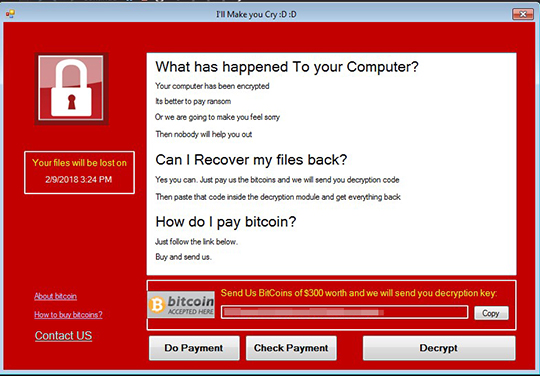RANSOM_MAKEUCRY.A
Mal/Genasom-A (SOPHOS_LITE), Trojan:Win32/Tiggre!rfn (MICROSOFT), Gen:Heur.Ransom.HiddenTears.1 (BITDEFENDER)
Windows


Threat Type: Ransomware
Destructiveness: No
Encrypted: No
In the wild: Yes
OVERVIEW
This Ransomware arrives on a system as a file dropped by other malware or as a file downloaded unknowingly by users when visiting malicious sites.
It connects to certain websites to send and receive information.
It encrypts files with specific file extensions. It encrypts files found in specific folders.
TECHNICAL DETAILS
Arrival Details
This Ransomware arrives on a system as a file dropped by other malware or as a file downloaded unknowingly by users when visiting malicious sites.
Installation
This Ransomware drops the following files:
- {Malware file path}\master_public_key.info
- {Malware file path}\master_pri_key.info
Other Details
This Ransomware connects to the following website to send and receive information:
- http://0cf5ff34.{BLOCKED}k.io/config/check/{user define token}/validate/{user defined key}
- http://0cf5ff34.{BLOCKED}k.io/config/check/{user defined characters}
It does the following:
- When executed, the malware informs the user of the encryption through a window message:

- After the malware has finished its encryption routine it displays the following:

Ransomware Routine
This Ransomware encrypts files with the following extensions:
- .JPG
- .GIF
- .PNG
- .NEF
- .ZIP
- .RAR
- .TAR
- .GZ
- .CS
- .VB
- .JAVA
- .CLASS
- .JS
- .VBS
- .CSC
- .JSON
- .TXT
- .C
- .CPP
- .H
- .CONFIG
- .PY
- .R
- .XAML
- .JSP
- .PHP
- .DOC
- .DOCX
- .XLS
- .XLSX
- .PPT
- .PPTX
- .MP3
- .MP4
- .AVI
- .MPEG
- .PST
- .MSG
- .EML
- .DBX
- .MBX
- .WAB
- .CAB
It encrypts files found in the following folders:
- F:\TEMP\{subfolders if any}
- D:\TEMP\ {subfolders if any}
- F:\Hardware-Ransom\ {subfolders if any}
SOLUTION
Step 1
Before doing any scans, Windows XP, Windows Vista, and Windows 7 users must disable System Restore to allow full scanning of their computers.
Step 2
Note that not all files, folders, and registry keys and entries are installed on your computer during this malware's/spyware's/grayware's execution. This may be due to incomplete installation or other operating system conditions. If you do not find the same files/folders/registry information, please proceed to the next step.
Step 3
Identify and terminate files detected as RANSOM_MAKEUCRY.A
- Windows Task Manager may not display all running processes. In this case, please use a third-party process viewer, preferably Process Explorer, to terminate the malware/grayware/spyware file. You may download the said tool here.
- If the detected file is displayed in either Windows Task Manager or Process Explorer but you cannot delete it, restart your computer in safe mode. To do this, refer to this link for the complete steps.
- If the detected file is not displayed in either Windows Task Manager or Process Explorer, continue doing the next steps.
Step 4
Search and delete this file
- {Malware file path}\master_public_key.info
- {Malware file path}\master_pri_key.info
Step 5
Scan your computer with your Trend Micro product to delete files detected as RANSOM_MAKEUCRY.A. If the detected files have already been cleaned, deleted, or quarantined by your Trend Micro product, no further step is required. You may opt to simply delete the quarantined files. Please check the following Trend Micro Support pages for more information:
Step 6
Restore encrypted files from backup.
Did this description help? Tell us how we did.

